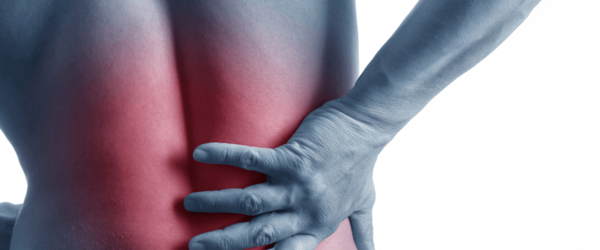Back pain is discomfort or often severe suffering linked with an injury or other ailment of the back, which spreads from the shoulders to the hips.
It results from an everyday action or chore done wrong –daily activities as ordinary as bending from your waist, moving heavy objects, and sitting at a computer in the same position for long hours. For example, shooting or stabbing pain might radiate from the back into the buttocks and thighs, as can tingle or burning sensations. Back pain can range from mild to severe, lasting for days, weeks, or even months.
When back pain strikes:
The bones in your spine, the vertebrae, are held together by a complex series of ligaments and muscles. When you participate in activities that strain these structures, tiny tears in the tissue can result, which can impact their stability. It happens in the lower back, which is called lower back strain. Symptoms aren’t just limited to the lower back, though. You can also feel pain in your shoulders, chest, back, or buttocks.
If you suffer from a lower back strain, activities that use other parts of your body that seem unrelated to your lower back can cause problems. This is because the nerves in your lower back are connected by intricate pathways of nerve fibers that run over your entire body. Lower back strain can cause pain during coughing and sneezing and can also cause:
- Muscle spasms
- Pain while yawning or stretching
- Pain in the groin or upper thighs
1) Inadequate Time in Bed:
Bed rest, which was once the primary mode of treatment, is no longer suggested. In today’s medical environment, it’s more important than ever to keep you mobile.
If your back pain is so severe that you cannot stand or sit erect, you may benefit from bed rest. So, if you have to stay in bed for more than a few hours at a time, try to keep it to a maximum of one or two days.
You should still engage in light physical activity even if you’re on bed rest. Make a habit of switching from one side of your body to the other. Stretch your arms and legs by bending and extending them. Shoulder rolls, neck, wrist, and ankle rotations are a couple of other options to think about as well.
2) Therapeutic Exercises:
As a result of regular exercise, you’ll have a more resilient physique that is less susceptible to injury. Strengthening your muscles also helps to support your spine’s joints, which in turn helps to alleviate joint discomfort. Back pain can be alleviated with physical activity by loosening up tight muscles. The release of endorphins, which operate on pain-relieving receptors in the brain, is another advantage.
The type of exercise you do will be determined by your current degree of fitness. If you’re starting, low-impact activities like walking, tai chi, pilates, and swimming are good options for you to try.
3) Increase fiber intake:
When fiber-rich foods are consumed, short-chain fatty acids (SCFAs) are generated in the colon by gut bacteria processing the fiber. These SCFAs help to maintain a healthy bacterial balance in your digestive system.
An increase in dangerous gut bacteria occurs when a balance is out of whack. Gut dysbiosis is the medical term for this illness, which is associated with an increased risk of Inflammation in the body. Chronic low back pain might develop as a result of persistent inflammation.
4) Use of Both Hot and Cold Therapy
Researchers have proved both heat and cold to be beneficial at relieving pain. Cold therapy is most effective within the first 48 to 72 hours following an injury or flare-up. The following are some of the perks of using this service:
- Lessened Inflammation
- Swelling is reduced and prevented
- Pain alleviation with numbing effect
Protect your skin from frostbite by applying cold therapy with an ice pack or cold compress covered with a cloth. Avoid exposing yourself to the cold for more than a few minutes.
Heat therapy (such as a heat wrap, heating pad, or hot water bottle) can be considered after 48-72 hours of back pain. Sore muscles can be soothed, blood flow can be increased to help heal, and stiff and achy joints can be relieved with the warmth. When using heat therapy, take extra care not to burn your skin.
5) Consider Using Herbal Remedies
Although further research is needed, there is evidence that herbs, essential oils, and alternative therapies can help alleviate back discomfort.
Consult a healthcare professional before using herbal treatment. This is extremely important if you’re taking medicine or have a preexisting medical condition. It’s vital to be aware of possible side effects and drug interactions when taking medication.
- Cherry acetic acid:They have anti-inflammatory and antioxidant benefits because of their polyphenol and vitamin C content. Recent research shows that cherry consumption reduces the signs of arthritis, Inflammation, and exercise-induced muscle soreness due to these effects.
- Green tea: In herbal tea antioxidant and anti-inflammatory properties make it a powerful supplement.
- The traditional use of turmeric: A Zingiberaceae herb, extends back hundreds of years. In turmeric, curcumin, which has anti-inflammatory qualities, is the active element. Studies on osteoarthritis patients have shown that curcumin can help alleviate pain and Inflammation.
- Ginger: Belongs to another Zingiberaceae family member, turmeric. Patients with arthritic problems benefit from ginger, according to studies.
- Lavender Oil: Aromatherapy with lavender oil has been studied for its pain-relieving properties. When children underwent tonsillectomy, those inhaling lavender oil required less pain medication. Adult participants in another study reported reduced tension and pain severity after receiving lavender aromatherapy.
6) Manage stress:
Stress has a direct correlation to how much pain you experience. Muscle tension and spasms are both caused by stress. There are a variety of ways to alleviate stress, including:
- Deep breathing:Take a few deep breaths daily for 10 to 20 minutes.
- Progressive muscles relaxation: While performing this exercise, you alternately contract and release your muscles, concentrating on one muscle group at a time. Start with your feet and work your way up to your neck and face, or you can do both.
- Yoga: Yoga is a sort of exercise consisting of a series of poses performed in a specific order. An emphasis is placed on the relationship between a person’s physical and mental selves. Flexibility and pain management can be improved by using it.
Managing low back pain with a natural approach has various alternatives. Acupuncture and biofeedback may also be options for additional treatment. Even though home cures are popular, if your back pain is severe, chronic, or worsening, you should see a doctor. See a doctor if your back discomfort lasts more than 48 hours or is accompanied by fever.
Back pain that stays untreated can steadily get worse and may turn into a chronic pain, therefore it’s a good thought to deal with your back pain today. No matter what kind of back pain you’re dealing with, the best course of action is to consult with one of our professional doctors and psychotherapist at DYNASTY CLINIC. We’ll guide you with the finest treatment strategy for back pain alleviation. Best Physiotherapy clinic dubai






